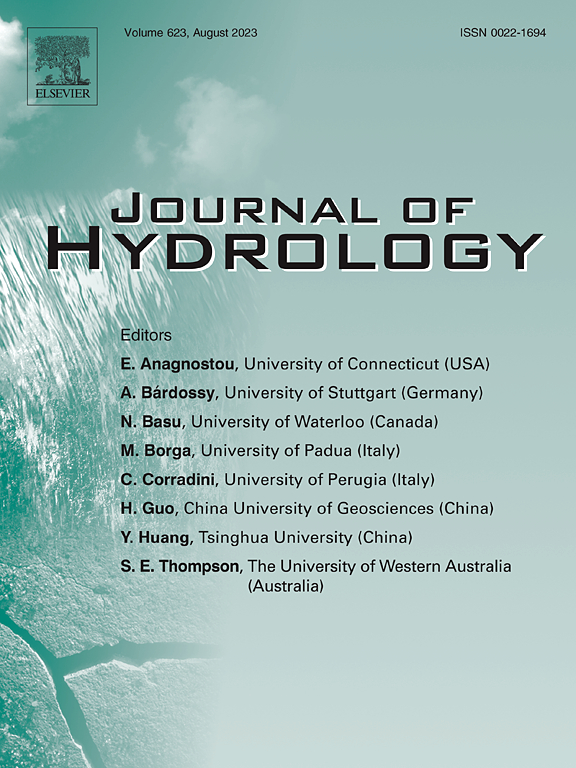Parametrization and model development for simulating redox reactions related to degradation of natural organic matter in managed aquifer recharge
IF 5.9
1区 地球科学
Q1 ENGINEERING, CIVIL
引用次数: 0
Abstract
Managed aquifer recharge (MAR) is commonly used as a treatment method to remove organic matter from surface water for a drinking water supply by filtering the water through soils in an aquifer. Groundwater, solute transport, and natural organic matter (NOM) degradation models are available for describing the processes, but their applications for practical assessment of MAR sites and their design have been limited. The objective of this study was to model the NOM processes, quantify the impacts of individual drivers on degradation, and identify the model parameters mainly controlling concentrations of organic matter, oxygen, Fe, and Mn. The methodological approach was to construct a 1-D reactive transport model for total organic carbon (TOC), dissolved oxygen (DO), Fe, Mn, and heat to address the key NOM processes in a lake-aquifer system, where lake water naturally infiltrates into an aquifer. The model was implemented with generalized likelihood uncertainty estimation (GLUE) and Sobol’s method to test the parameter sensitivity.The results showed that in addition to reactions in the aquifer, the lake bottom sediment model played a key role in bank infiltration through its control of DO concentrations. The model was able to represent the diminishing effect of strong temperature seasonality and smoothening of the temperature-related concentration variations in the aquifer. On the other hand, the model produced seasonal TOC dynamics close to the lake-aquifer interface, which was not detected in measurements. With GLUE, the TOC and DO concentrations in the model were most sensitive to the seepage velocity, the hydrodynamic dispersivity, and the reaction rate parameters controlling the oxygen-related degradation of TOC in the lake sediment and the aquifer. Sobol’s total order indexes also showed sensitivity to parameters that control the temperature dependency of reaction rates. In addition to these parameters, Mn and Fe concentrations were sensitive to reaction rate factors for the dissolution of Mn in the aquifer, but the result was less clear. The resulting identification of the key parameters provides a benchmark for the calibration of bank filtration models in the Nordic context.
模拟含水层补给中自然有机质降解氧化还原反应的参数化和模型开发
含水层管理补给(MAR)通常被用作一种处理方法,通过含水层中的土壤过滤水,从地表水中去除有机物以提供饮用水。地下水、溶质运移和天然有机质(NOM)降解模型可用于描述这一过程,但它们在MAR场地的实际评估和设计中的应用受到限制。本研究的目的是建立NOM过程模型,量化各个驱动因素对降解的影响,并确定主要控制有机物、氧、铁和锰浓度的模型参数。方法方法是构建总有机碳(TOC)、溶解氧(DO)、铁(Fe)、锰(Mn)和热量的一维反应输运模型,以解决湖泊-含水层系统中湖泊水自然渗入含水层的关键NOM过程。该模型采用广义似然不确定性估计(GLUE)和Sobol方法来检验参数的灵敏度。结果表明,除了含水层的反应外,湖底沉积物模型还通过控制DO浓度对河岸入渗起关键作用。该模型能够表现出强烈的温度季节性效应的减弱和含水层中与温度相关的浓度变化的平滑。另一方面,该模型产生了接近湖泊-含水层界面的季节TOC动态,这在测量中没有检测到。使用GLUE时,模型中TOC和DO浓度对渗流速度、水动力分散性以及控制湖泊沉积物和含水层中TOC氧相关降解的反应速率参数最为敏感。Sobol的总序指数对控制反应速率的温度依赖性的参数也表现出敏感性。除这些参数外,Mn和Fe浓度对含水层中Mn溶解的反应速率因子敏感,但结果不太清楚。由此确定的关键参数为北欧背景下的河岸过滤模型的校准提供了基准。
本文章由计算机程序翻译,如有差异,请以英文原文为准。
求助全文
约1分钟内获得全文
求助全文
来源期刊

Journal of Hydrology
地学-地球科学综合
CiteScore
11.00
自引率
12.50%
发文量
1309
审稿时长
7.5 months
期刊介绍:
The Journal of Hydrology publishes original research papers and comprehensive reviews in all the subfields of the hydrological sciences including water based management and policy issues that impact on economics and society. These comprise, but are not limited to the physical, chemical, biogeochemical, stochastic and systems aspects of surface and groundwater hydrology, hydrometeorology and hydrogeology. Relevant topics incorporating the insights and methodologies of disciplines such as climatology, water resource systems, hydraulics, agrohydrology, geomorphology, soil science, instrumentation and remote sensing, civil and environmental engineering are included. Social science perspectives on hydrological problems such as resource and ecological economics, environmental sociology, psychology and behavioural science, management and policy analysis are also invited. Multi-and interdisciplinary analyses of hydrological problems are within scope. The science published in the Journal of Hydrology is relevant to catchment scales rather than exclusively to a local scale or site.
 求助内容:
求助内容: 应助结果提醒方式:
应助结果提醒方式:


